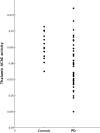The cholinergic system and Parkinson disease
- PMID: 20060022
- PMCID: PMC2888997
- DOI: 10.1016/j.bbr.2009.12.048
The cholinergic system and Parkinson disease
Abstract
Although Parkinson disease (PD) is viewed traditionally as a motor syndrome secondary to nigrostriatal dopaminergic denervation, recent studies emphasize non-motor features. Non-motor comorbidities, such as cognitive impairment, are likely the result of an intricate interplay of multi-system degenerations and neurotransmitter deficiencies extending beyond the loss of dopaminergic nigral neurons. The pathological hallmark of parkinsonian dementia is the presence of extra-nigral Lewy bodies that can be accompanied by other pathologies, such as senile plaques. Lewy first identified the eponymous Lewy body in neurons of the nucleus basalis of Meynert (nbM), the source of cholinergic innervation of the cerebral cortex. Although cholinergic denervation is recognized as a pathological hallmark of Alzheimer disease (AD), in vivo neuroimaging studies reveal loss of cerebral cholinergic markers in parkinsonian dementia similar to or more severe than in prototypical AD. Imaging studies agree with post-mortem evidence suggesting that basal forebrain cholinergic system degeneration appears early in PD and worsens coincident with the appearance of dementia. Early cholinergic denervation in PD without dementia appears to be heterogeneous and may make specific contributions to the PD clinical phenotype. Apart from well-known cognitive and behavioral deficits, central, in particular limbic, cholinergic denervation may be associated with progressive deficits of odor identification in PD. Recent evidence indicates also that subcortical cholinergic denervation, probably due to degeneration of brainstem pedunculopontine nucleus neurons, may relate to the presence of dopamine non-responsive gait and balance impairments, including falls, in PD.
Published by Elsevier B.V.
Figures



References
-
- Aarsland D, Kurz MW. The epidemiology of dementia associated with Parkinson disease. J Neurol Sci. 2009 - PubMed
-
- Apicella P, Scarnati E, Schultz W. Tonically discharging neurons of monkey striatum respond to preparatory and rewarding stimuli. Exp Brain Res. 1991;84:672–5. - PubMed
-
- Arendt T, Bigl V, Arendt A, Tennstedt A. Loss of neurons in the nucleus basalis of Meynert in Alzheimer's disease, paralysis agitans and Korsakoff's Disease. Acta Neuropathol (Berl) 1983;61:101–108. - PubMed
-
- Atack JR, Perry EK, Bonham JR, Candy JM, Perry RH. Molecular forms of acetylcholinesterase and butyrylcholinesterase in the aged human central nervous system. J Neurochem. 1986;47:263–277. - PubMed
Publication types
MeSH terms
Substances
Grants and funding
LinkOut - more resources
Full Text Sources
Other Literature Sources
Medical

